Trip Report – Ultimate Antarctica 2009
November 16 – December 10, 2009
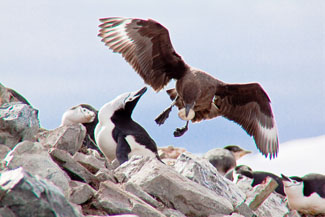
photo by Jim Wood, Australia
Ironically, in a ship filled with serious and/or professional photographers, the best image from the trip was made by a passenger who has owned his camera for about a month. Jim Wood, from Australia, was at the right place at the right time when a Southern Skua, a predatory seabird that resembles a jaeger or thick, brown gull, worried a Chinstrap Penguin nest until, with a quick dive and snatch, the skua grabbed a penguin egg from beneath the incubating hen. Jim captured the whole sequence, but the shot, as the bird lifted off into the air with egg in beak, the complaining penguin screeching at the sky, was the show-stopper when we did our group slide show at trip’s end.

That statement was not to demean the luck or skill of the other photographers, but illustrates so clearly the quality of photography we had. This was our third trip to the South – the Falklands, South Georgia, and the Antarctic Peninsula – where we co-led a trip for Joe Van Os on his Ultimate Antarctic Tour, and I felt it was the best we have experienced. It was our earliest trip, ever, leaving in mid-November and extending until early December, in what might be called early summer in that latitude. We were expecting plenty of cold and snow but had relatively little, and whether or not that was testament or not to climate change or global warming, it was nevertheless much warmer than we had expected.
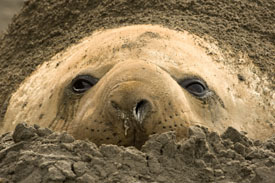
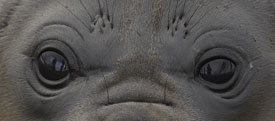
Elephant Seals - a bull buried in the sand and a 'weaner,'
a baby that has not yet gone to sea, lying on the beach.
This early in the season birds were nesting, and all were on eggs or building nests. Elephant seals were concluding their breeding season, and Southern Fur Lions had not yet begun in earnest. We did see a few of the first fur seal births, but the beaches were still fairly empty of aggressive, harem-building males that, on previous trips, had made some landings a true battle. Years ago, on my very first trip South, the leaders came ashore with long bamboo poles that were used to keep charging fur seals at bay. This year, with the exception of a few feisty males that gaped or did short mock charges, moving along the beach and tussock grass was positively benign.
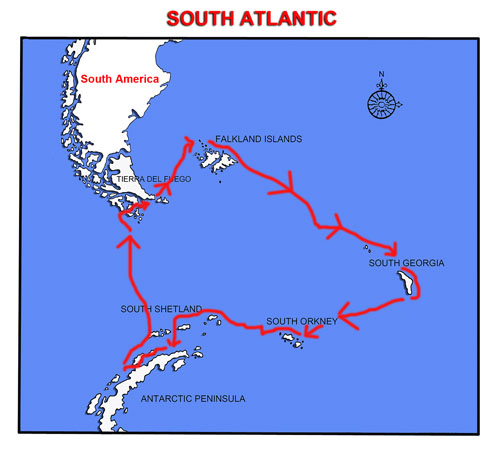
Our trip, like most tours to the South, started in Ushauia, Argentina, the southernmost city in the world. Even in mid November the temperature was still clement and we walked the streets in light jackets or sweaters. In the Falklands, our first stop, we had one day that was truly summer-like, where, on New Island, we photographed in shirt sleeves or light sweaters along an expansive bay that was nearly mirror-like in the still, warm air.
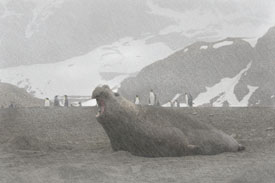 South Georgia, an island outpost in the middle of the South Atlantic, where winds and waves travel unimpeded from the north, was our first taste of truly polar weather, but even here we only had snow-covered landscapes to shoreline at our first landing. Elsewhere, at varying spots, we had snow flurries, sleet, or freezing rain, as well as drenching rain showers. We also had sunny days and, in truth, as is typical for that area, we had every mix of weather on any given day. The elephant seal image, on the left, shows a snow storm scene, completely recreated in Photoshop. It is the only image in this portfolio doctored in Photoshop, but I've included it here because it accurately illustrates what we saw on the island before I had a chance to begin shooting. You'd learn how to create this effect in our Advanced Photoshop class, Taking the Next Step with Ellen Anon.
South Georgia, an island outpost in the middle of the South Atlantic, where winds and waves travel unimpeded from the north, was our first taste of truly polar weather, but even here we only had snow-covered landscapes to shoreline at our first landing. Elsewhere, at varying spots, we had snow flurries, sleet, or freezing rain, as well as drenching rain showers. We also had sunny days and, in truth, as is typical for that area, we had every mix of weather on any given day. The elephant seal image, on the left, shows a snow storm scene, completely recreated in Photoshop. It is the only image in this portfolio doctored in Photoshop, but I've included it here because it accurately illustrates what we saw on the island before I had a chance to begin shooting. You'd learn how to create this effect in our Advanced Photoshop class, Taking the Next Step with Ellen Anon.
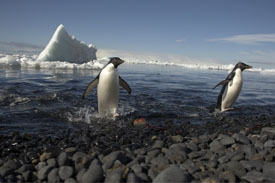
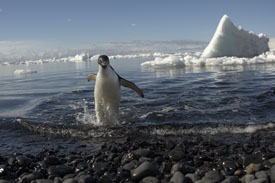
Adelie Penguins rushing to shore on the Peninsula, where Mary lay flat
on the beach waiting for this small penguin to come to shore.
On the Antarctica Peninsula, where islands and fingers of land lessen the effects of the wind and current, we had the longest string of good weather, including two days where we photographed without jackets. Like South Georgia, we had every mix of weather through the day and one that may have started pleasant and warm, as we waited to board our zodiacs, might turn to frigid temperatures shortly after we would land. The rule was, prepare for everything, and we did.
Antarctic trips can be marred by bad weather and such heavy winds and seas that landings can be treacherous or impossible. I’ve heard horror stories where travelers were skunked for nearly an entire trip, but we’ve always been lucky, and this trip was no exception. In fact, in that regard it was exceptional, as we had 19 landings and 5 zodiac cruises, with only two or three beaches proving inaccessible because of wind and high surf. At one beach, our party of leaders landed first to assess the situation and as we explored options our expedition leader, on an off-shore zodiac, radioed for us to evacuate. The surf, problematic when we landed, had intensified to five foot swells and climbing aboard a bouncing zodiac, and launching same, was a true challenge. We aborted that landing and moved elsewhere.
For this trip we used our Kiboko backpacks. This is the first time we used the bags on an extensive trip, and the bags held up wonderfully. Because of our weight limitations, we also wore the packs as we traveled through the airports and although the bags were heavy -- due to the amount of gear we had wedged inside -- they were comfortable, and my initial positive response and report on the bags has not been changed. Most days I carried my 500mm, mounted on a camera, and a 28-300mm mounted on a camera, and a 16-35mm wide angle, unmounted, inside the bag. Sometimes I'd include a flash -- which I rarely used, or a shotgun microphone, mic cord, and digital tape recorder, all inside the bag. When we came ashore, or exited, we loaded our Kiboko bags into Cabela's Dry Bags, which protected the bag and content from the salt water that sometimes washed over the zodiac.
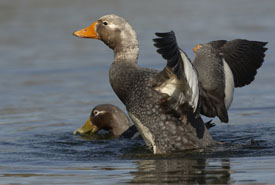
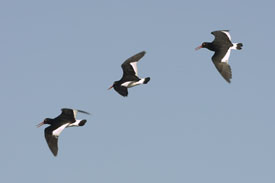
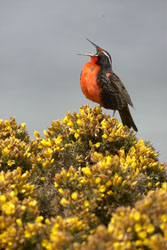
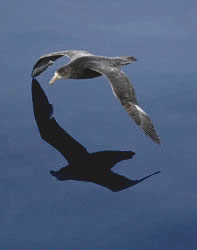
Falkland Island Flightless Steamer Duck, Pied Oystercatcher,
Long-tailed Meadowlark, Giant Petrel in flight -- all by Mary
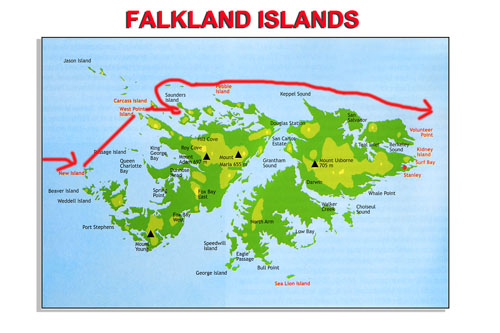
On most days, when we were within reach of land, we made two landings, exploring new sites each time. In the Falklands that included New Island, two visits, West Point and Carcass, and a very rainy, incredibly windy morning on Saunders Island. Fortunately at Saunders we had anchored on the lee side of the wind, and our boat and landing was protected by a long stretch of beach. As soon as we rounded the crest of the beach we experienced the full force of near gale force winds, with horizontal rains and occasional stinging bouts of sleet. David Pole-Evans, the owner of Saunders and an old friend from previous visits to the island, drove out in his 4x4 to say hi, and in the shelter of the lee side of his jeep we reminisced and endured the weather.
In contrast, at New Island we landed and departed from a beach that was pond-like in its stillness, and from that edge photographers shot Rock Cormorants, two species of Oystercatcher, two species of Geese, the Flightless Falkland Steamer Duck, and various birds. On Carcass, Mary and I spent the first part of a cold, drizzly afternoon photographing Pied Oystercatchers feeding on tidal worms at surf side so close that they intruded on the minimum focus of our lenses, and a cryptic Falkland Snipe that blended perfectly into the tussock grasses when still. We had an opportunity to visit with another old friend, Rob McGill and his wife, and inspect the completely renovated guest rooms that were not there when we last did a trip to these islands.
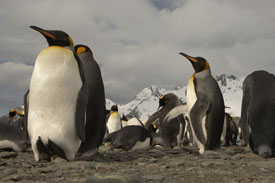
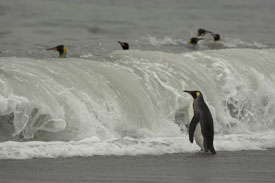
King Penguins nesting and in the surf at South Georgia, by Mary
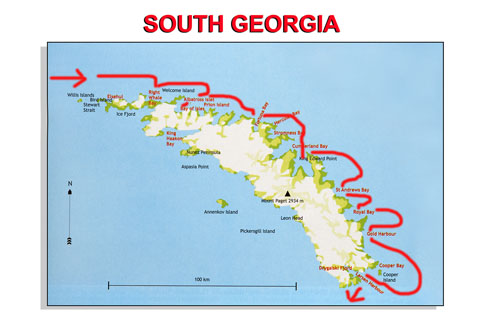
In many ways South Georgia epitomizes the South, and the photographic opportunities here, especially for wildlife, is the best of the three destinations. While King Penguins nest on the Falklands in small numbers, and elsewhere around the South Atlantic, on South Georgia the Kings may be in their densest numbers, at least when one considers the accessibility, however remote, of the various locations. Here, at both Salisbury Plains and at Saint Andrews Bay, are two of the most spectacular wildlife spectacles one can ever see, anywhere, as literally thousands of birds – 150,000 nesting pairs at Saint Andrews, for example – line the beaches, stream edges, and hillsides in a carpet of black and white.
At this time of year the Kings are concluding one nesting cycle, with young mollywogs clad in a coat of fur-like brown feathers, huddle in crèches waiting for an adult to return from the sea to feed and gleaming adults beginning their courtship rituals prior to egg-laying. We saw plenty of head-pointing and trumpeting and much courting, and a few matings as well. Hundreds of dead chicks were scattered along the colony and on the beaches, perhaps the result of adults lost at sea from natural causes, or perhaps an indication of over-fishing in the surrounding seas, even though the area around SGI is free from commercial fishing.
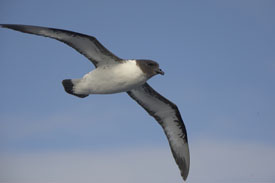
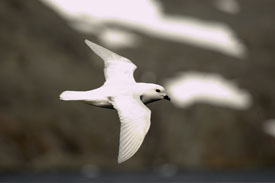
Cape Petrel and the rare and beautiful Snow Petrel, both by Mary
Disappointingly, the Wandering Albatross colonies at Bird and Prion Islands are now off-limits during the tourist season, so our only views of Wanders was from the boat as adults and juveniles sailed past.(Please Note: We'll be joining Joseph Van Os Photo Tours again in 2011, for another November trip. But this time, our trip will be early enough in November to enable us to visit the Wandering Albatross nesting colonies at either Prion or Bird Islands). From that same vantage we saw our only Gray-Headed Albatrosses, but on the shore at several locations we did see and film the subtly beautiful Light-Mantled Sooty Albatrosses that nest on steep cliffs , hidden among the tussocks.
We had some luck as we sailed the potentially monstrous seas from South Georgia to the Orkney’s and the Peninsula. A huge wind storm was forecasted, but it veered north of our route and dissipated, somewhat, as we sailed. Still, as is typical it was a rocky, bouncing journey for most of the trip, despite the lure of new Antarctic birds sailing by and following our boat.
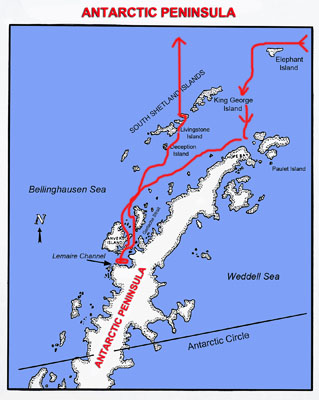
Our time on the Antarctic Peninsula was characterized by some of the best light and conditions we experienced on the entire trip, albeit between bouts of snow, sleet, wind, fog, and heavy cloud cover. Two incredible weather days stand out, with one, our anchorage at Neco Harbor at dawn so captivating that some photographers stayed up all night to shoot the sunset and, that morning, the alpen glow of dawn. In that pre-6AM light the bay was still, and Gentoo Penguins cruised around the boat, leaping clear of the water and forming perfect reflections of the leaps. I was on deck by 5:30 and missed the best penguin leaps, and indeed I was always at the wrong place at the wrong time whenever one swam close and leaped. I caught the tail-end of a large avalanche that crashed into the bay, sending up a plume of ice crystals that nearly covered the entire width of the bay.
Our other stellar day was at Half Moon Bay on the afternoon of our very last landing before heading back to Ushuaia. The landing started as many do, with a chill wind and overcast skies, and frankly, many of us were ready to pack up and head north, exhausted and sated with a good trip. In the course of that afternoon’s landing, however, the weather once again varied from chill, overcast conditions to sparkling sunshine in sweater weather. In those sparkling conditions, from atop a hillside overlooking a iceberg-filled and glacier-edged bay, with encircling mountains etched by long shadows and topped by wisps of clouds snagged along the tips and ridges, we photographed our final Chinstraps in truly one of the most beautiful locations I’ve seen.
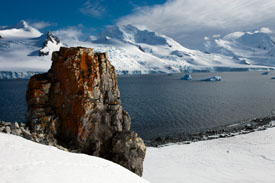
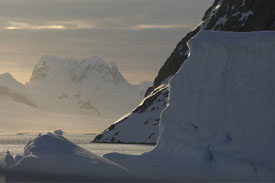
Half-Moon Bay, on our last afternoon at our last landing, and
icebergs and mountain scapes near the Lemaire Channel
It’s often said that Antartica is one of the most beautiful locations on earth, and the destination of the privileged or wealthy, and one might wonder if the hype lives up to the reputation. Perhaps there are more beautiful locations on this planet, but a vista such as this makes one wonder. Perhaps a part of this magic is due to the gift of good light and weather when it happens, when the skies part and the sun shines and a landscape like no other is revealed at its best. Perhaps, if every day was blue-bird skies and warm this sense of wonder and uniqueness might be lost, but that’s hardly a concern here in the South for a string of such days are few.
Fortunately for us, the leaders of this expedition, the weather finally closed and as the sun dropped, when long shadows and etched light would be at its greatest, the clouds moved in and the light failed. I say fortunately because if the light hadn't failed we'd never have left this final stop, it simply was too beautiful. With a growing chill and dulling light we boarded the zodiacs, and started our very bumpy cruise back to South America.
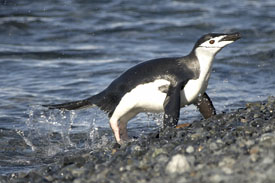
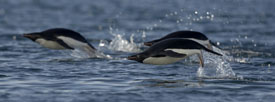
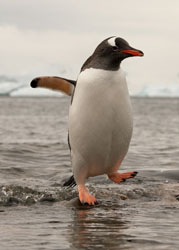
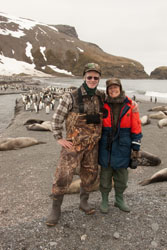
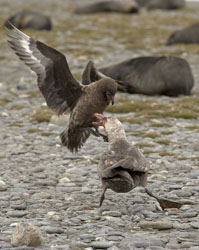
Chinstrap penguin coming ashore, Adelie penguins porpoising,
Gentoo penguin dancing, Joe and Mary (she is overdressed!) at South Georgia,
and a skua and petrel fighting over a carcass.
As I write this, several highlights come to mind.
The bellow of bull Elephant seals claiming or contesting their beaches on South Georgia,
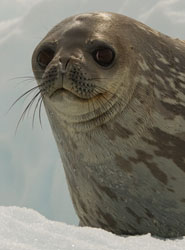
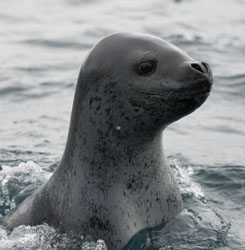
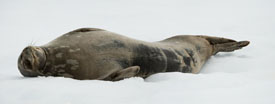
The incredible seal viewing opportunities we had on the Peninsula, where we had a very curious Leopard Seal and the best Weddell's Seals ever,
The fighting and scavenging among Southern Skuas and Giant Petrels, scrabbling
over recently killed King Penguins,
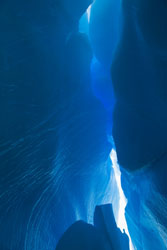
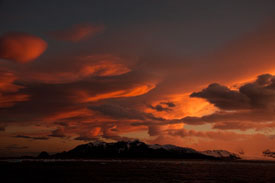
The landscapes - the incredible lenticular clouds glowing brightly over the South Georgia mountains at sunset, and the icebergs and ice caves on the peninsula,
and
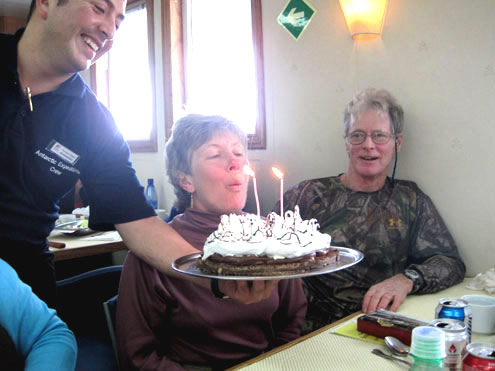 Mary's birthday party on the boat, a wonderful place to celebrate and party as we headed from South Georgia to the Antarctic Peninsula.
Mary's birthday party on the boat, a wonderful place to celebrate and party as we headed from South Georgia to the Antarctic Peninsula.
In addition to this Trip Report, I also keep a daily journal that describes the day-to-day activities, the specific sites we visited, and the wildlife, landscapes, and adventures we encountered. This Journal may give you an even better idea of what you can expect if you would do this trip with us in the future.
If you enjoyed this Trip Report, you may wish to read some of our other Trip Reports detailing our travels in South America, Africa, and elsewhere.
We will be doing this trip again in November of 2011, visiting the Falkland Islands, South Georgia, and the Antarctic Peninsula. We expect this trip to be in early November, allowing us to visit the Wandering Albatross islands in South Georgia. By mid-November, those islands are closed to tourist visitation but this trip will coincide with visiting days. Further, the incredible Elephant Seal will be winding up their breeding activity, so there may be bulls fighting on the beach. Penguins will have started their nesting activity, and hopefully, with colder spring weather there will be snow and snow blizzards to make spectacular images with penguins. This trip, like all of our Antarctic tours, is run by Joseph Van Os Photo Safaris, and we function as two of the leaders in these groups. It's a great time, and this will be our fourth time co-leading these tours in Antarctic. Join us!
On a final note, many of the more serious photographers on the trip expressed an interest in understanding manual metering for making an exposure. Most were using Aperture Priority, which works wonderfully much of the time. But it fails in contrasty situations, like black cliffs forming a background for middle-tone subjects, or seabirds bouncing between bright, overcast skies and dark, turbulent seas. In those times, Aperture Priority may overexpose (black backgrounds) or underexpose (bright sky backgrounds), where Manual Mode, if done correctly, would provide a consistently accurate exposure. You can learn how to become a master of Manual Exposure, as well as a wealth of other vital photographic and digital skills, at our Digital Complete Nature Photo Course, held in both Arizona and in Pennsylvania. See also the December 2009-January 2010 Question of the Month, addressing Manual Exposure.
See More of our
Ultimate Antarctica 2009 Portfolio
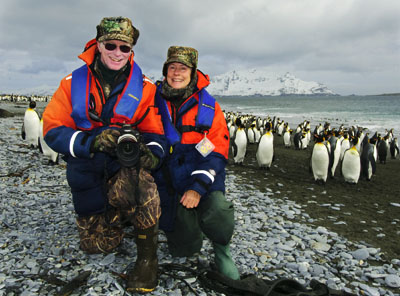
Trip Report – Ultimate Antarctica 2009
November 16 – December 10, 2009

photo by Jim Wood, Australia
Ironically, in a ship filled with serious and/or professional photographers, the best image from the trip was made by a passenger who has owned his camera for about a month. Jim Wood, from Australia, was at the right place at the right time when a Southern Skua, a predatory seabird that resembles a jaeger or thick, brown gull, worried a Chinstrap Penguin nest until, with a quick dive and snatch, the skua grabbed a penguin egg from beneath the incubating hen. Jim captured the whole sequence, but the shot, as the bird lifted off into the air with egg in beak, the complaining penguin screeching at the sky, was the show-stopper when we did our group slide show at trip’s end.

That statement was not to demean the luck or skill of the other photographers, but illustrates so clearly the quality of photography we had. This was our third trip to the South – the Falklands, South Georgia, and the Antarctic Peninsula – where we co-led a trip for Joe Van Os on his Ultimate Antarctic Tour, and I felt it was the best we have experienced. It was our earliest trip, ever, leaving in mid-November and extending until early December, in what might be called early summer in that latitude. We were expecting plenty of cold and snow but had relatively little, and whether or not that was testament or not to climate change or global warming, it was nevertheless much warmer than we had expected.


Elephant Seals - a bull buried in the sand and a 'weaner,'
a baby that has not yet gone to sea, lying on the beach.
This early in the season birds were nesting, and all were on eggs or building nests. Elephant seals were concluding their breeding season, and Southern Fur Lions had not yet begun in earnest. We did see a few of the first fur seal births, but the beaches were still fairly empty of aggressive, harem-building males that, on previous trips, had made some landings a true battle. Years ago, on my very first trip South, the leaders came ashore with long bamboo poles that were used to keep charging fur seals at bay. This year, with the exception of a few feisty males that gaped or did short mock charges, moving along the beach and tussock grass was positively benign.

Our trip, like most tours to the South, started in Ushauia, Argentina, the southernmost city in the world. Even in mid November the temperature was still clement and we walked the streets in light jackets or sweaters. In the Falklands, our first stop, we had one day that was truly summer-like, where, on New Island, we photographed in shirt sleeves or light sweaters along an expansive bay that was nearly mirror-like in the still, warm air.
 South Georgia, an island outpost in the middle of the South Atlantic, where winds and waves travel unimpeded from the north, was our first taste of truly polar weather, but even here we only had snow-covered landscapes to shoreline at our first landing. Elsewhere, at varying spots, we had snow flurries, sleet, or freezing rain, as well as drenching rain showers. We also had sunny days and, in truth, as is typical for that area, we had every mix of weather on any given day. The elephant seal image, on the left, shows a snow storm scene, completely recreated in Photoshop. It is the only image in this portfolio doctored in Photoshop, but I've included it here because it accurately illustrates what we saw on the island before I had a chance to begin shooting. You'd learn how to create this effect in our Advanced Photoshop class, Taking the Next Step with Ellen Anon.
South Georgia, an island outpost in the middle of the South Atlantic, where winds and waves travel unimpeded from the north, was our first taste of truly polar weather, but even here we only had snow-covered landscapes to shoreline at our first landing. Elsewhere, at varying spots, we had snow flurries, sleet, or freezing rain, as well as drenching rain showers. We also had sunny days and, in truth, as is typical for that area, we had every mix of weather on any given day. The elephant seal image, on the left, shows a snow storm scene, completely recreated in Photoshop. It is the only image in this portfolio doctored in Photoshop, but I've included it here because it accurately illustrates what we saw on the island before I had a chance to begin shooting. You'd learn how to create this effect in our Advanced Photoshop class, Taking the Next Step with Ellen Anon.


Adelie Penguins rushing to shore on the Peninsula, where Mary lay flat
on the beach waiting for this small penguin to come to shore.
On the Antarctica Peninsula, where islands and fingers of land lessen the effects of the wind and current, we had the longest string of good weather, including two days where we photographed without jackets. Like South Georgia, we had every mix of weather through the day and one that may have started pleasant and warm, as we waited to board our zodiacs, might turn to frigid temperatures shortly after we would land. The rule was, prepare for everything, and we did.
Antarctic trips can be marred by bad weather and such heavy winds and seas that landings can be treacherous or impossible. I’ve heard horror stories where travelers were skunked for nearly an entire trip, but we’ve always been lucky, and this trip was no exception. In fact, in that regard it was exceptional, as we had 19 landings and 5 zodiac cruises, with only two or three beaches proving inaccessible because of wind and high surf. At one beach, our party of leaders landed first to assess the situation and as we explored options our expedition leader, on an off-shore zodiac, radioed for us to evacuate. The surf, problematic when we landed, had intensified to five foot swells and climbing aboard a bouncing zodiac, and launching same, was a true challenge. We aborted that landing and moved elsewhere.
For this trip we used our Kiboko backpacks. This is the first time we used the bags on an extensive trip, and the bags held up wonderfully. Because of our weight limitations, we also wore the packs as we traveled through the airports and although the bags were heavy -- due to the amount of gear we had wedged inside -- they were comfortable, and my initial positive response and report on the bags has not been changed. Most days I carried my 500mm, mounted on a camera, and a 28-300mm mounted on a camera, and a 16-35mm wide angle, unmounted, inside the bag. Sometimes I'd include a flash -- which I rarely used, or a shotgun microphone, mic cord, and digital tape recorder, all inside the bag. When we came ashore, or exited, we loaded our Kiboko bags into Cabela's Dry Bags, which protected the bag and content from the salt water that sometimes washed over the zodiac.




Falkland Island Flightless Steamer Duck, Pied Oystercatcher,
Long-tailed Meadowlark, Giant Petrel in flight -- all by Mary

On most days, when we were within reach of land, we made two landings, exploring new sites each time. In the Falklands that included New Island, two visits, West Point and Carcass, and a very rainy, incredibly windy morning on Saunders Island. Fortunately at Saunders we had anchored on the lee side of the wind, and our boat and landing was protected by a long stretch of beach. As soon as we rounded the crest of the beach we experienced the full force of near gale force winds, with horizontal rains and occasional stinging bouts of sleet. David Pole-Evans, the owner of Saunders and an old friend from previous visits to the island, drove out in his 4x4 to say hi, and in the shelter of the lee side of his jeep we reminisced and endured the weather.
In contrast, at New Island we landed and departed from a beach that was pond-like in its stillness, and from that edge photographers shot Rock Cormorants, two species of Oystercatcher, two species of Geese, the Flightless Falkland Steamer Duck, and various birds. On Carcass, Mary and I spent the first part of a cold, drizzly afternoon photographing Pied Oystercatchers feeding on tidal worms at surf side so close that they intruded on the minimum focus of our lenses, and a cryptic Falkland Snipe that blended perfectly into the tussock grasses when still. We had an opportunity to visit with another old friend, Rob McGill and his wife, and inspect the completely renovated guest rooms that were not there when we last did a trip to these islands.


King Penguins nesting and in the surf at South Georgia, by Mary

In many ways South Georgia epitomizes the South, and the photographic opportunities here, especially for wildlife, is the best of the three destinations. While King Penguins nest on the Falklands in small numbers, and elsewhere around the South Atlantic, on South Georgia the Kings may be in their densest numbers, at least when one considers the accessibility, however remote, of the various locations. Here, at both Salisbury Plains and at Saint Andrews Bay, are two of the most spectacular wildlife spectacles one can ever see, anywhere, as literally thousands of birds – 150,000 nesting pairs at Saint Andrews, for example – line the beaches, stream edges, and hillsides in a carpet of black and white.
At this time of year the Kings are concluding one nesting cycle, with young mollywogs clad in a coat of fur-like brown feathers, huddle in crèches waiting for an adult to return from the sea to feed and gleaming adults beginning their courtship rituals prior to egg-laying. We saw plenty of head-pointing and trumpeting and much courting, and a few matings as well. Hundreds of dead chicks were scattered along the colony and on the beaches, perhaps the result of adults lost at sea from natural causes, or perhaps an indication of over-fishing in the surrounding seas, even though the area around SGI is free from commercial fishing.


Cape Petrel and the rare and beautiful Snow Petrel, both by Mary
Disappointingly, the Wandering Albatross colonies at Bird and Prion Islands are now off-limits during the tourist season, so our only views of Wanders was from the boat as adults and juveniles sailed past.(Please Note: We'll be joining Joseph Van Os Photo Tours again in 2011, for another November trip. But this time, our trip will be early enough in November to enable us to visit the Wandering Albatross nesting colonies at either Prion or Bird Islands). From that same vantage we saw our only Gray-Headed Albatrosses, but on the shore at several locations we did see and film the subtly beautiful Light-Mantled Sooty Albatrosses that nest on steep cliffs , hidden among the tussocks.
We had some luck as we sailed the potentially monstrous seas from South Georgia to the Orkney’s and the Peninsula. A huge wind storm was forecasted, but it veered north of our route and dissipated, somewhat, as we sailed. Still, as is typical it was a rocky, bouncing journey for most of the trip, despite the lure of new Antarctic birds sailing by and following our boat.

Our time on the Antarctic Peninsula was characterized by some of the best light and conditions we experienced on the entire trip, albeit between bouts of snow, sleet, wind, fog, and heavy cloud cover. Two incredible weather days stand out, with one, our anchorage at Neco Harbor at dawn so captivating that some photographers stayed up all night to shoot the sunset and, that morning, the alpen glow of dawn. In that pre-6AM light the bay was still, and Gentoo Penguins cruised around the boat, leaping clear of the water and forming perfect reflections of the leaps. I was on deck by 5:30 and missed the best penguin leaps, and indeed I was always at the wrong place at the wrong time whenever one swam close and leaped. I caught the tail-end of a large avalanche that crashed into the bay, sending up a plume of ice crystals that nearly covered the entire width of the bay.
Our other stellar day was at Half Moon Bay on the afternoon of our very last landing before heading back to Ushuaia. The landing started as many do, with a chill wind and overcast skies, and frankly, many of us were ready to pack up and head north, exhausted and sated with a good trip. In the course of that afternoon’s landing, however, the weather once again varied from chill, overcast conditions to sparkling sunshine in sweater weather. In those sparkling conditions, from atop a hillside overlooking a iceberg-filled and glacier-edged bay, with encircling mountains etched by long shadows and topped by wisps of clouds snagged along the tips and ridges, we photographed our final Chinstraps in truly one of the most beautiful locations I’ve seen.


Half-Moon Bay, on our last afternoon at our last landing, and
icebergs and mountain scapes near the Lemaire Channel
It’s often said that Antartica is one of the most beautiful locations on earth, and the destination of the privileged or wealthy, and one might wonder if the hype lives up to the reputation. Perhaps there are more beautiful locations on this planet, but a vista such as this makes one wonder. Perhaps a part of this magic is due to the gift of good light and weather when it happens, when the skies part and the sun shines and a landscape like no other is revealed at its best. Perhaps, if every day was blue-bird skies and warm this sense of wonder and uniqueness might be lost, but that’s hardly a concern here in the South for a string of such days are few.
Fortunately for us, the leaders of this expedition, the weather finally closed and as the sun dropped, when long shadows and etched light would be at its greatest, the clouds moved in and the light failed. I say fortunately because if the light hadn't failed we'd never have left this final stop, it simply was too beautiful. With a growing chill and dulling light we boarded the zodiacs, and started our very bumpy cruise back to South America.





Chinstrap penguin coming ashore, Adelie penguins porpoising,
Gentoo penguin dancing, Joe and Mary (she is overdressed!) at South Georgia,
and a skua and petrel fighting over a carcass.
As I write this, several highlights come to mind.
The bellow of bull Elephant seals claiming or contesting their beaches on South Georgia,



The incredible seal viewing opportunities we had on the Peninsula, where we had a very curious Leopard Seal and the best Weddell's Seals ever,
The fighting and scavenging among Southern Skuas and Giant Petrels, scrabbling
over recently killed King Penguins,


The landscapes - the incredible lenticular clouds glowing brightly over the South Georgia mountains at sunset, and the icebergs and ice caves on the peninsula,
and
 Mary's birthday party on the boat, a wonderful place to celebrate and party as we headed from South Georgia to the Antarctic Peninsula.
Mary's birthday party on the boat, a wonderful place to celebrate and party as we headed from South Georgia to the Antarctic Peninsula.
In addition to this Trip Report, I also keep a daily journal that describes the day-to-day activities, the specific sites we visited, and the wildlife, landscapes, and adventures we encountered. This Journal may give you an even better idea of what you can expect if you would do this trip with us in the future.
If you enjoyed this Trip Report, you may wish to read some of our other Trip Reports detailing our travels in South America, Africa, and elsewhere.
We will be doing this trip again in November of 2011, visiting the Falkland Islands, South Georgia, and the Antarctic Peninsula. We expect this trip to be in early November, allowing us to visit the Wandering Albatross islands in South Georgia. By mid-November, those islands are closed to tourist visitation but this trip will coincide with visiting days. Further, the incredible Elephant Seal will be winding up their breeding activity, so there may be bulls fighting on the beach. Penguins will have started their nesting activity, and hopefully, with colder spring weather there will be snow and snow blizzards to make spectacular images with penguins. This trip, like all of our Antarctic tours, is run by Joseph Van Os Photo Safaris, and we function as two of the leaders in these groups. It's a great time, and this will be our fourth time co-leading these tours in Antarctic. Join us!
On a final note, many of the more serious photographers on the trip expressed an interest in understanding manual metering for making an exposure. Most were using Aperture Priority, which works wonderfully much of the time. But it fails in contrasty situations, like black cliffs forming a background for middle-tone subjects, or seabirds bouncing between bright, overcast skies and dark, turbulent seas. In those times, Aperture Priority may overexpose (black backgrounds) or underexpose (bright sky backgrounds), where Manual Mode, if done correctly, would provide a consistently accurate exposure. You can learn how to become a master of Manual Exposure, as well as a wealth of other vital photographic and digital skills, at our Digital Complete Nature Photo Course, held in both Arizona and in Pennsylvania. See also the December 2009-January 2010 Question of the Month, addressing Manual Exposure.
See More of our
Ultimate Antarctica 2009 Portfolio

Trip Report – Ultimate Antarctica 2009
November 16 – December 10, 2009

photo by Jim Wood, Australia
Ironically, in a ship filled with serious and/or professional photographers, the best image from the trip was made by a passenger who has owned his camera for about a month. Jim Wood, from Australia, was at the right place at the right time when a Southern Skua, a predatory seabird that resembles a jaeger or thick, brown gull, worried a Chinstrap Penguin nest until, with a quick dive and snatch, the skua grabbed a penguin egg from beneath the incubating hen. Jim captured the whole sequence, but the shot, as the bird lifted off into the air with egg in beak, the complaining penguin screeching at the sky, was the show-stopper when we did our group slide show at trip’s end.

That statement was not to demean the luck or skill of the other photographers, but illustrates so clearly the quality of photography we had. This was our third trip to the South – the Falklands, South Georgia, and the Antarctic Peninsula – where we co-led a trip for Joe Van Os on his Ultimate Antarctic Tour, and I felt it was the best we have experienced. It was our earliest trip, ever, leaving in mid-November and extending until early December, in what might be called early summer in that latitude. We were expecting plenty of cold and snow but had relatively little, and whether or not that was testament or not to climate change or global warming, it was nevertheless much warmer than we had expected.


Elephant Seals - a bull buried in the sand and a 'weaner,'
a baby that has not yet gone to sea, lying on the beach.
This early in the season birds were nesting, and all were on eggs or building nests. Elephant seals were concluding their breeding season, and Southern Fur Lions had not yet begun in earnest. We did see a few of the first fur seal births, but the beaches were still fairly empty of aggressive, harem-building males that, on previous trips, had made some landings a true battle. Years ago, on my very first trip South, the leaders came ashore with long bamboo poles that were used to keep charging fur seals at bay. This year, with the exception of a few feisty males that gaped or did short mock charges, moving along the beach and tussock grass was positively benign.

Our trip, like most tours to the South, started in Ushauia, Argentina, the southernmost city in the world. Even in mid November the temperature was still clement and we walked the streets in light jackets or sweaters. In the Falklands, our first stop, we had one day that was truly summer-like, where, on New Island, we photographed in shirt sleeves or light sweaters along an expansive bay that was nearly mirror-like in the still, warm air.
 South Georgia, an island outpost in the middle of the South Atlantic, where winds and waves travel unimpeded from the north, was our first taste of truly polar weather, but even here we only had snow-covered landscapes to shoreline at our first landing. Elsewhere, at varying spots, we had snow flurries, sleet, or freezing rain, as well as drenching rain showers. We also had sunny days and, in truth, as is typical for that area, we had every mix of weather on any given day. The elephant seal image, on the left, shows a snow storm scene, completely recreated in Photoshop. It is the only image in this portfolio doctored in Photoshop, but I've included it here because it accurately illustrates what we saw on the island before I had a chance to begin shooting. You'd learn how to create this effect in our Advanced Photoshop class, Taking the Next Step with Ellen Anon.
South Georgia, an island outpost in the middle of the South Atlantic, where winds and waves travel unimpeded from the north, was our first taste of truly polar weather, but even here we only had snow-covered landscapes to shoreline at our first landing. Elsewhere, at varying spots, we had snow flurries, sleet, or freezing rain, as well as drenching rain showers. We also had sunny days and, in truth, as is typical for that area, we had every mix of weather on any given day. The elephant seal image, on the left, shows a snow storm scene, completely recreated in Photoshop. It is the only image in this portfolio doctored in Photoshop, but I've included it here because it accurately illustrates what we saw on the island before I had a chance to begin shooting. You'd learn how to create this effect in our Advanced Photoshop class, Taking the Next Step with Ellen Anon.


Adelie Penguins rushing to shore on the Peninsula, where Mary lay flat
on the beach waiting for this small penguin to come to shore.
On the Antarctica Peninsula, where islands and fingers of land lessen the effects of the wind and current, we had the longest string of good weather, including two days where we photographed without jackets. Like South Georgia, we had every mix of weather through the day and one that may have started pleasant and warm, as we waited to board our zodiacs, might turn to frigid temperatures shortly after we would land. The rule was, prepare for everything, and we did.
Antarctic trips can be marred by bad weather and such heavy winds and seas that landings can be treacherous or impossible. I’ve heard horror stories where travelers were skunked for nearly an entire trip, but we’ve always been lucky, and this trip was no exception. In fact, in that regard it was exceptional, as we had 19 landings and 5 zodiac cruises, with only two or three beaches proving inaccessible because of wind and high surf. At one beach, our party of leaders landed first to assess the situation and as we explored options our expedition leader, on an off-shore zodiac, radioed for us to evacuate. The surf, problematic when we landed, had intensified to five foot swells and climbing aboard a bouncing zodiac, and launching same, was a true challenge. We aborted that landing and moved elsewhere.
For this trip we used our Kiboko backpacks. This is the first time we used the bags on an extensive trip, and the bags held up wonderfully. Because of our weight limitations, we also wore the packs as we traveled through the airports and although the bags were heavy -- due to the amount of gear we had wedged inside -- they were comfortable, and my initial positive response and report on the bags has not been changed. Most days I carried my 500mm, mounted on a camera, and a 28-300mm mounted on a camera, and a 16-35mm wide angle, unmounted, inside the bag. Sometimes I'd include a flash -- which I rarely used, or a shotgun microphone, mic cord, and digital tape recorder, all inside the bag. When we came ashore, or exited, we loaded our Kiboko bags into Cabela's Dry Bags, which protected the bag and content from the salt water that sometimes washed over the zodiac.




Falkland Island Flightless Steamer Duck, Pied Oystercatcher,
Long-tailed Meadowlark, Giant Petrel in flight -- all by Mary

On most days, when we were within reach of land, we made two landings, exploring new sites each time. In the Falklands that included New Island, two visits, West Point and Carcass, and a very rainy, incredibly windy morning on Saunders Island. Fortunately at Saunders we had anchored on the lee side of the wind, and our boat and landing was protected by a long stretch of beach. As soon as we rounded the crest of the beach we experienced the full force of near gale force winds, with horizontal rains and occasional stinging bouts of sleet. David Pole-Evans, the owner of Saunders and an old friend from previous visits to the island, drove out in his 4x4 to say hi, and in the shelter of the lee side of his jeep we reminisced and endured the weather.
In contrast, at New Island we landed and departed from a beach that was pond-like in its stillness, and from that edge photographers shot Rock Cormorants, two species of Oystercatcher, two species of Geese, the Flightless Falkland Steamer Duck, and various birds. On Carcass, Mary and I spent the first part of a cold, drizzly afternoon photographing Pied Oystercatchers feeding on tidal worms at surf side so close that they intruded on the minimum focus of our lenses, and a cryptic Falkland Snipe that blended perfectly into the tussock grasses when still. We had an opportunity to visit with another old friend, Rob McGill and his wife, and inspect the completely renovated guest rooms that were not there when we last did a trip to these islands.


King Penguins nesting and in the surf at South Georgia, by Mary

In many ways South Georgia epitomizes the South, and the photographic opportunities here, especially for wildlife, is the best of the three destinations. While King Penguins nest on the Falklands in small numbers, and elsewhere around the South Atlantic, on South Georgia the Kings may be in their densest numbers, at least when one considers the accessibility, however remote, of the various locations. Here, at both Salisbury Plains and at Saint Andrews Bay, are two of the most spectacular wildlife spectacles one can ever see, anywhere, as literally thousands of birds – 150,000 nesting pairs at Saint Andrews, for example – line the beaches, stream edges, and hillsides in a carpet of black and white.
At this time of year the Kings are concluding one nesting cycle, with young mollywogs clad in a coat of fur-like brown feathers, huddle in crèches waiting for an adult to return from the sea to feed and gleaming adults beginning their courtship rituals prior to egg-laying. We saw plenty of head-pointing and trumpeting and much courting, and a few matings as well. Hundreds of dead chicks were scattered along the colony and on the beaches, perhaps the result of adults lost at sea from natural causes, or perhaps an indication of over-fishing in the surrounding seas, even though the area around SGI is free from commercial fishing.


Cape Petrel and the rare and beautiful Snow Petrel, both by Mary
Disappointingly, the Wandering Albatross colonies at Bird and Prion Islands are now off-limits during the tourist season, so our only views of Wanders was from the boat as adults and juveniles sailed past.(Please Note: We'll be joining Joseph Van Os Photo Tours again in 2011, for another November trip. But this time, our trip will be early enough in November to enable us to visit the Wandering Albatross nesting colonies at either Prion or Bird Islands). From that same vantage we saw our only Gray-Headed Albatrosses, but on the shore at several locations we did see and film the subtly beautiful Light-Mantled Sooty Albatrosses that nest on steep cliffs , hidden among the tussocks.
We had some luck as we sailed the potentially monstrous seas from South Georgia to the Orkney’s and the Peninsula. A huge wind storm was forecasted, but it veered north of our route and dissipated, somewhat, as we sailed. Still, as is typical it was a rocky, bouncing journey for most of the trip, despite the lure of new Antarctic birds sailing by and following our boat.

Our time on the Antarctic Peninsula was characterized by some of the best light and conditions we experienced on the entire trip, albeit between bouts of snow, sleet, wind, fog, and heavy cloud cover. Two incredible weather days stand out, with one, our anchorage at Neco Harbor at dawn so captivating that some photographers stayed up all night to shoot the sunset and, that morning, the alpen glow of dawn. In that pre-6AM light the bay was still, and Gentoo Penguins cruised around the boat, leaping clear of the water and forming perfect reflections of the leaps. I was on deck by 5:30 and missed the best penguin leaps, and indeed I was always at the wrong place at the wrong time whenever one swam close and leaped. I caught the tail-end of a large avalanche that crashed into the bay, sending up a plume of ice crystals that nearly covered the entire width of the bay.
Our other stellar day was at Half Moon Bay on the afternoon of our very last landing before heading back to Ushuaia. The landing started as many do, with a chill wind and overcast skies, and frankly, many of us were ready to pack up and head north, exhausted and sated with a good trip. In the course of that afternoon’s landing, however, the weather once again varied from chill, overcast conditions to sparkling sunshine in sweater weather. In those sparkling conditions, from atop a hillside overlooking a iceberg-filled and glacier-edged bay, with encircling mountains etched by long shadows and topped by wisps of clouds snagged along the tips and ridges, we photographed our final Chinstraps in truly one of the most beautiful locations I’ve seen.


Half-Moon Bay, on our last afternoon at our last landing, and
icebergs and mountain scapes near the Lemaire Channel
It’s often said that Antartica is one of the most beautiful locations on earth, and the destination of the privileged or wealthy, and one might wonder if the hype lives up to the reputation. Perhaps there are more beautiful locations on this planet, but a vista such as this makes one wonder. Perhaps a part of this magic is due to the gift of good light and weather when it happens, when the skies part and the sun shines and a landscape like no other is revealed at its best. Perhaps, if every day was blue-bird skies and warm this sense of wonder and uniqueness might be lost, but that’s hardly a concern here in the South for a string of such days are few.
Fortunately for us, the leaders of this expedition, the weather finally closed and as the sun dropped, when long shadows and etched light would be at its greatest, the clouds moved in and the light failed. I say fortunately because if the light hadn't failed we'd never have left this final stop, it simply was too beautiful. With a growing chill and dulling light we boarded the zodiacs, and started our very bumpy cruise back to South America.





Chinstrap penguin coming ashore, Adelie penguins porpoising,
Gentoo penguin dancing, Joe and Mary (she is overdressed!) at South Georgia,
and a skua and petrel fighting over a carcass.
As I write this, several highlights come to mind.
The bellow of bull Elephant seals claiming or contesting their beaches on South Georgia,



The incredible seal viewing opportunities we had on the Peninsula, where we had a very curious Leopard Seal and the best Weddell's Seals ever,
The fighting and scavenging among Southern Skuas and Giant Petrels, scrabbling
over recently killed King Penguins,


The landscapes - the incredible lenticular clouds glowing brightly over the South Georgia mountains at sunset, and the icebergs and ice caves on the peninsula,
and
 Mary's birthday party on the boat, a wonderful place to celebrate and party as we headed from South Georgia to the Antarctic Peninsula.
Mary's birthday party on the boat, a wonderful place to celebrate and party as we headed from South Georgia to the Antarctic Peninsula.
In addition to this Trip Report, I also keep a daily journal that describes the day-to-day activities, the specific sites we visited, and the wildlife, landscapes, and adventures we encountered. This Journal may give you an even better idea of what you can expect if you would do this trip with us in the future.
If you enjoyed this Trip Report, you may wish to read some of our other Trip Reports detailing our travels in South America, Africa, and elsewhere.
We will be doing this trip again in November of 2011, visiting the Falkland Islands, South Georgia, and the Antarctic Peninsula. We expect this trip to be in early November, allowing us to visit the Wandering Albatross islands in South Georgia. By mid-November, those islands are closed to tourist visitation but this trip will coincide with visiting days. Further, the incredible Elephant Seal will be winding up their breeding activity, so there may be bulls fighting on the beach. Penguins will have started their nesting activity, and hopefully, with colder spring weather there will be snow and snow blizzards to make spectacular images with penguins. This trip, like all of our Antarctic tours, is run by Joseph Van Os Photo Safaris, and we function as two of the leaders in these groups. It's a great time, and this will be our fourth time co-leading these tours in Antarctic. Join us!
On a final note, many of the more serious photographers on the trip expressed an interest in understanding manual metering for making an exposure. Most were using Aperture Priority, which works wonderfully much of the time. But it fails in contrasty situations, like black cliffs forming a background for middle-tone subjects, or seabirds bouncing between bright, overcast skies and dark, turbulent seas. In those times, Aperture Priority may overexpose (black backgrounds) or underexpose (bright sky backgrounds), where Manual Mode, if done correctly, would provide a consistently accurate exposure. You can learn how to become a master of Manual Exposure, as well as a wealth of other vital photographic and digital skills, at our Digital Complete Nature Photo Course, held in both Arizona and in Pennsylvania. See also the December 2009-January 2010 Question of the Month, addressing Manual Exposure.
See More of our
Ultimate Antarctica 2009 Portfolio

Trip Report – Ultimate Antarctica 2009
November 16 – December 10, 2009

photo by Jim Wood, Australia
Ironically, in a ship filled with serious and/or professional photographers, the best image from the trip was made by a passenger who has owned his camera for about a month. Jim Wood, from Australia, was at the right place at the right time when a Southern Skua, a predatory seabird that resembles a jaeger or thick, brown gull, worried a Chinstrap Penguin nest until, with a quick dive and snatch, the skua grabbed a penguin egg from beneath the incubating hen. Jim captured the whole sequence, but the shot, as the bird lifted off into the air with egg in beak, the complaining penguin screeching at the sky, was the show-stopper when we did our group slide show at trip’s end.

That statement was not to demean the luck or skill of the other photographers, but illustrates so clearly the quality of photography we had. This was our third trip to the South – the Falklands, South Georgia, and the Antarctic Peninsula – where we co-led a trip for Joe Van Os on his Ultimate Antarctic Tour, and I felt it was the best we have experienced. It was our earliest trip, ever, leaving in mid-November and extending until early December, in what might be called early summer in that latitude. We were expecting plenty of cold and snow but had relatively little, and whether or not that was testament or not to climate change or global warming, it was nevertheless much warmer than we had expected.


Elephant Seals - a bull buried in the sand and a 'weaner,'
a baby that has not yet gone to sea, lying on the beach.
This early in the season birds were nesting, and all were on eggs or building nests. Elephant seals were concluding their breeding season, and Southern Fur Lions had not yet begun in earnest. We did see a few of the first fur seal births, but the beaches were still fairly empty of aggressive, harem-building males that, on previous trips, had made some landings a true battle. Years ago, on my very first trip South, the leaders came ashore with long bamboo poles that were used to keep charging fur seals at bay. This year, with the exception of a few feisty males that gaped or did short mock charges, moving along the beach and tussock grass was positively benign.

Our trip, like most tours to the South, started in Ushauia, Argentina, the southernmost city in the world. Even in mid November the temperature was still clement and we walked the streets in light jackets or sweaters. In the Falklands, our first stop, we had one day that was truly summer-like, where, on New Island, we photographed in shirt sleeves or light sweaters along an expansive bay that was nearly mirror-like in the still, warm air.
 South Georgia, an island outpost in the middle of the South Atlantic, where winds and waves travel unimpeded from the north, was our first taste of truly polar weather, but even here we only had snow-covered landscapes to shoreline at our first landing. Elsewhere, at varying spots, we had snow flurries, sleet, or freezing rain, as well as drenching rain showers. We also had sunny days and, in truth, as is typical for that area, we had every mix of weather on any given day. The elephant seal image, on the left, shows a snow storm scene, completely recreated in Photoshop. It is the only image in this portfolio doctored in Photoshop, but I've included it here because it accurately illustrates what we saw on the island before I had a chance to begin shooting. You'd learn how to create this effect in our Advanced Photoshop class, Taking the Next Step with Ellen Anon.
South Georgia, an island outpost in the middle of the South Atlantic, where winds and waves travel unimpeded from the north, was our first taste of truly polar weather, but even here we only had snow-covered landscapes to shoreline at our first landing. Elsewhere, at varying spots, we had snow flurries, sleet, or freezing rain, as well as drenching rain showers. We also had sunny days and, in truth, as is typical for that area, we had every mix of weather on any given day. The elephant seal image, on the left, shows a snow storm scene, completely recreated in Photoshop. It is the only image in this portfolio doctored in Photoshop, but I've included it here because it accurately illustrates what we saw on the island before I had a chance to begin shooting. You'd learn how to create this effect in our Advanced Photoshop class, Taking the Next Step with Ellen Anon.


Adelie Penguins rushing to shore on the Peninsula, where Mary lay flat
on the beach waiting for this small penguin to come to shore.
On the Antarctica Peninsula, where islands and fingers of land lessen the effects of the wind and current, we had the longest string of good weather, including two days where we photographed without jackets. Like South Georgia, we had every mix of weather through the day and one that may have started pleasant and warm, as we waited to board our zodiacs, might turn to frigid temperatures shortly after we would land. The rule was, prepare for everything, and we did.
Antarctic trips can be marred by bad weather and such heavy winds and seas that landings can be treacherous or impossible. I’ve heard horror stories where travelers were skunked for nearly an entire trip, but we’ve always been lucky, and this trip was no exception. In fact, in that regard it was exceptional, as we had 19 landings and 5 zodiac cruises, with only two or three beaches proving inaccessible because of wind and high surf. At one beach, our party of leaders landed first to assess the situation and as we explored options our expedition leader, on an off-shore zodiac, radioed for us to evacuate. The surf, problematic when we landed, had intensified to five foot swells and climbing aboard a bouncing zodiac, and launching same, was a true challenge. We aborted that landing and moved elsewhere.
For this trip we used our Kiboko backpacks. This is the first time we used the bags on an extensive trip, and the bags held up wonderfully. Because of our weight limitations, we also wore the packs as we traveled through the airports and although the bags were heavy -- due to the amount of gear we had wedged inside -- they were comfortable, and my initial positive response and report on the bags has not been changed. Most days I carried my 500mm, mounted on a camera, and a 28-300mm mounted on a camera, and a 16-35mm wide angle, unmounted, inside the bag. Sometimes I'd include a flash -- which I rarely used, or a shotgun microphone, mic cord, and digital tape recorder, all inside the bag. When we came ashore, or exited, we loaded our Kiboko bags into Cabela's Dry Bags, which protected the bag and content from the salt water that sometimes washed over the zodiac.




Falkland Island Flightless Steamer Duck, Pied Oystercatcher,
Long-tailed Meadowlark, Giant Petrel in flight -- all by Mary

On most days, when we were within reach of land, we made two landings, exploring new sites each time. In the Falklands that included New Island, two visits, West Point and Carcass, and a very rainy, incredibly windy morning on Saunders Island. Fortunately at Saunders we had anchored on the lee side of the wind, and our boat and landing was protected by a long stretch of beach. As soon as we rounded the crest of the beach we experienced the full force of near gale force winds, with horizontal rains and occasional stinging bouts of sleet. David Pole-Evans, the owner of Saunders and an old friend from previous visits to the island, drove out in his 4x4 to say hi, and in the shelter of the lee side of his jeep we reminisced and endured the weather.
In contrast, at New Island we landed and departed from a beach that was pond-like in its stillness, and from that edge photographers shot Rock Cormorants, two species of Oystercatcher, two species of Geese, the Flightless Falkland Steamer Duck, and various birds. On Carcass, Mary and I spent the first part of a cold, drizzly afternoon photographing Pied Oystercatchers feeding on tidal worms at surf side so close that they intruded on the minimum focus of our lenses, and a cryptic Falkland Snipe that blended perfectly into the tussock grasses when still. We had an opportunity to visit with another old friend, Rob McGill and his wife, and inspect the completely renovated guest rooms that were not there when we last did a trip to these islands.


King Penguins nesting and in the surf at South Georgia, by Mary

In many ways South Georgia epitomizes the South, and the photographic opportunities here, especially for wildlife, is the best of the three destinations. While King Penguins nest on the Falklands in small numbers, and elsewhere around the South Atlantic, on South Georgia the Kings may be in their densest numbers, at least when one considers the accessibility, however remote, of the various locations. Here, at both Salisbury Plains and at Saint Andrews Bay, are two of the most spectacular wildlife spectacles one can ever see, anywhere, as literally thousands of birds – 150,000 nesting pairs at Saint Andrews, for example – line the beaches, stream edges, and hillsides in a carpet of black and white.
At this time of year the Kings are concluding one nesting cycle, with young mollywogs clad in a coat of fur-like brown feathers, huddle in crèches waiting for an adult to return from the sea to feed and gleaming adults beginning their courtship rituals prior to egg-laying. We saw plenty of head-pointing and trumpeting and much courting, and a few matings as well. Hundreds of dead chicks were scattered along the colony and on the beaches, perhaps the result of adults lost at sea from natural causes, or perhaps an indication of over-fishing in the surrounding seas, even though the area around SGI is free from commercial fishing.


Cape Petrel and the rare and beautiful Snow Petrel, both by Mary
Disappointingly, the Wandering Albatross colonies at Bird and Prion Islands are now off-limits during the tourist season, so our only views of Wanders was from the boat as adults and juveniles sailed past.(Please Note: We'll be joining Joseph Van Os Photo Tours again in 2011, for another November trip. But this time, our trip will be early enough in November to enable us to visit the Wandering Albatross nesting colonies at either Prion or Bird Islands). From that same vantage we saw our only Gray-Headed Albatrosses, but on the shore at several locations we did see and film the subtly beautiful Light-Mantled Sooty Albatrosses that nest on steep cliffs , hidden among the tussocks.
We had some luck as we sailed the potentially monstrous seas from South Georgia to the Orkney’s and the Peninsula. A huge wind storm was forecasted, but it veered north of our route and dissipated, somewhat, as we sailed. Still, as is typical it was a rocky, bouncing journey for most of the trip, despite the lure of new Antarctic birds sailing by and following our boat.

Our time on the Antarctic Peninsula was characterized by some of the best light and conditions we experienced on the entire trip, albeit between bouts of snow, sleet, wind, fog, and heavy cloud cover. Two incredible weather days stand out, with one, our anchorage at Neco Harbor at dawn so captivating that some photographers stayed up all night to shoot the sunset and, that morning, the alpen glow of dawn. In that pre-6AM light the bay was still, and Gentoo Penguins cruised around the boat, leaping clear of the water and forming perfect reflections of the leaps. I was on deck by 5:30 and missed the best penguin leaps, and indeed I was always at the wrong place at the wrong time whenever one swam close and leaped. I caught the tail-end of a large avalanche that crashed into the bay, sending up a plume of ice crystals that nearly covered the entire width of the bay.
Our other stellar day was at Half Moon Bay on the afternoon of our very last landing before heading back to Ushuaia. The landing started as many do, with a chill wind and overcast skies, and frankly, many of us were ready to pack up and head north, exhausted and sated with a good trip. In the course of that afternoon’s landing, however, the weather once again varied from chill, overcast conditions to sparkling sunshine in sweater weather. In those sparkling conditions, from atop a hillside overlooking a iceberg-filled and glacier-edged bay, with encircling mountains etched by long shadows and topped by wisps of clouds snagged along the tips and ridges, we photographed our final Chinstraps in truly one of the most beautiful locations I’ve seen.


Half-Moon Bay, on our last afternoon at our last landing, and
icebergs and mountain scapes near the Lemaire Channel
It’s often said that Antartica is one of the most beautiful locations on earth, and the destination of the privileged or wealthy, and one might wonder if the hype lives up to the reputation. Perhaps there are more beautiful locations on this planet, but a vista such as this makes one wonder. Perhaps a part of this magic is due to the gift of good light and weather when it happens, when the skies part and the sun shines and a landscape like no other is revealed at its best. Perhaps, if every day was blue-bird skies and warm this sense of wonder and uniqueness might be lost, but that’s hardly a concern here in the South for a string of such days are few.
Fortunately for us, the leaders of this expedition, the weather finally closed and as the sun dropped, when long shadows and etched light would be at its greatest, the clouds moved in and the light failed. I say fortunately because if the light hadn't failed we'd never have left this final stop, it simply was too beautiful. With a growing chill and dulling light we boarded the zodiacs, and started our very bumpy cruise back to South America.





Chinstrap penguin coming ashore, Adelie penguins porpoising,
Gentoo penguin dancing, Joe and Mary (she is overdressed!) at South Georgia,
and a skua and petrel fighting over a carcass.
As I write this, several highlights come to mind.
The bellow of bull Elephant seals claiming or contesting their beaches on South Georgia,



The incredible seal viewing opportunities we had on the Peninsula, where we had a very curious Leopard Seal and the best Weddell's Seals ever,
The fighting and scavenging among Southern Skuas and Giant Petrels, scrabbling
over recently killed King Penguins,


The landscapes - the incredible lenticular clouds glowing brightly over the South Georgia mountains at sunset, and the icebergs and ice caves on the peninsula,
and
 Mary's birthday party on the boat, a wonderful place to celebrate and party as we headed from South Georgia to the Antarctic Peninsula.
Mary's birthday party on the boat, a wonderful place to celebrate and party as we headed from South Georgia to the Antarctic Peninsula.
In addition to this Trip Report, I also keep a daily journal that describes the day-to-day activities, the specific sites we visited, and the wildlife, landscapes, and adventures we encountered. This Journal may give you an even better idea of what you can expect if you would do this trip with us in the future.
If you enjoyed this Trip Report, you may wish to read some of our other Trip Reports detailing our travels in South America, Africa, and elsewhere.
We will be doing this trip again in November of 2011, visiting the Falkland Islands, South Georgia, and the Antarctic Peninsula. We expect this trip to be in early November, allowing us to visit the Wandering Albatross islands in South Georgia. By mid-November, those islands are closed to tourist visitation but this trip will coincide with visiting days. Further, the incredible Elephant Seal will be winding up their breeding activity, so there may be bulls fighting on the beach. Penguins will have started their nesting activity, and hopefully, with colder spring weather there will be snow and snow blizzards to make spectacular images with penguins. This trip, like all of our Antarctic tours, is run by Joseph Van Os Photo Safaris, and we function as two of the leaders in these groups. It's a great time, and this will be our fourth time co-leading these tours in Antarctic. Join us!
On a final note, many of the more serious photographers on the trip expressed an interest in understanding manual metering for making an exposure. Most were using Aperture Priority, which works wonderfully much of the time. But it fails in contrasty situations, like black cliffs forming a background for middle-tone subjects, or seabirds bouncing between bright, overcast skies and dark, turbulent seas. In those times, Aperture Priority may overexpose (black backgrounds) or underexpose (bright sky backgrounds), where Manual Mode, if done correctly, would provide a consistently accurate exposure. You can learn how to become a master of Manual Exposure, as well as a wealth of other vital photographic and digital skills, at our Digital Complete Nature Photo Course, held in both Arizona and in Pennsylvania. See also the December 2009-January 2010 Question of the Month, addressing Manual Exposure.
See More of our
Ultimate Antarctica 2009 Portfolio

Trip Report – Ultimate Antarctica 2009
November 16 – December 10, 2009

photo by Jim Wood, Australia
Ironically, in a ship filled with serious and/or professional photographers, the best image from the trip was made by a passenger who has owned his camera for about a month. Jim Wood, from Australia, was at the right place at the right time when a Southern Skua, a predatory seabird that resembles a jaeger or thick, brown gull, worried a Chinstrap Penguin nest until, with a quick dive and snatch, the skua grabbed a penguin egg from beneath the incubating hen. Jim captured the whole sequence, but the shot, as the bird lifted off into the air with egg in beak, the complaining penguin screeching at the sky, was the show-stopper when we did our group slide show at trip’s end.

That statement was not to demean the luck or skill of the other photographers, but illustrates so clearly the quality of photography we had. This was our third trip to the South – the Falklands, South Georgia, and the Antarctic Peninsula – where we co-led a trip for Joe Van Os on his Ultimate Antarctic Tour, and I felt it was the best we have experienced. It was our earliest trip, ever, leaving in mid-November and extending until early December, in what might be called early summer in that latitude. We were expecting plenty of cold and snow but had relatively little, and whether or not that was testament or not to climate change or global warming, it was nevertheless much warmer than we had expected.


Elephant Seals - a bull buried in the sand and a 'weaner,'
a baby that has not yet gone to sea, lying on the beach.
This early in the season birds were nesting, and all were on eggs or building nests. Elephant seals were concluding their breeding season, and Southern Fur Lions had not yet begun in earnest. We did see a few of the first fur seal births, but the beaches were still fairly empty of aggressive, harem-building males that, on previous trips, had made some landings a true battle. Years ago, on my very first trip South, the leaders came ashore with long bamboo poles that were used to keep charging fur seals at bay. This year, with the exception of a few feisty males that gaped or did short mock charges, moving along the beach and tussock grass was positively benign.

Our trip, like most tours to the South, started in Ushauia, Argentina, the southernmost city in the world. Even in mid November the temperature was still clement and we walked the streets in light jackets or sweaters. In the Falklands, our first stop, we had one day that was truly summer-like, where, on New Island, we photographed in shirt sleeves or light sweaters along an expansive bay that was nearly mirror-like in the still, warm air.
 South Georgia, an island outpost in the middle of the South Atlantic, where winds and waves travel unimpeded from the north, was our first taste of truly polar weather, but even here we only had snow-covered landscapes to shoreline at our first landing. Elsewhere, at varying spots, we had snow flurries, sleet, or freezing rain, as well as drenching rain showers. We also had sunny days and, in truth, as is typical for that area, we had every mix of weather on any given day. The elephant seal image, on the left, shows a snow storm scene, completely recreated in Photoshop. It is the only image in this portfolio doctored in Photoshop, but I've included it here because it accurately illustrates what we saw on the island before I had a chance to begin shooting. You'd learn how to create this effect in our Advanced Photoshop class, Taking the Next Step with Ellen Anon.
South Georgia, an island outpost in the middle of the South Atlantic, where winds and waves travel unimpeded from the north, was our first taste of truly polar weather, but even here we only had snow-covered landscapes to shoreline at our first landing. Elsewhere, at varying spots, we had snow flurries, sleet, or freezing rain, as well as drenching rain showers. We also had sunny days and, in truth, as is typical for that area, we had every mix of weather on any given day. The elephant seal image, on the left, shows a snow storm scene, completely recreated in Photoshop. It is the only image in this portfolio doctored in Photoshop, but I've included it here because it accurately illustrates what we saw on the island before I had a chance to begin shooting. You'd learn how to create this effect in our Advanced Photoshop class, Taking the Next Step with Ellen Anon.


Adelie Penguins rushing to shore on the Peninsula, where Mary lay flat
on the beach waiting for this small penguin to come to shore.
On the Antarctica Peninsula, where islands and fingers of land lessen the effects of the wind and current, we had the longest string of good weather, including two days where we photographed without jackets. Like South Georgia, we had every mix of weather through the day and one that may have started pleasant and warm, as we waited to board our zodiacs, might turn to frigid temperatures shortly after we would land. The rule was, prepare for everything, and we did.
Antarctic trips can be marred by bad weather and such heavy winds and seas that landings can be treacherous or impossible. I’ve heard horror stories where travelers were skunked for nearly an entire trip, but we’ve always been lucky, and this trip was no exception. In fact, in that regard it was exceptional, as we had 19 landings and 5 zodiac cruises, with only two or three beaches proving inaccessible because of wind and high surf. At one beach, our party of leaders landed first to assess the situation and as we explored options our expedition leader, on an off-shore zodiac, radioed for us to evacuate. The surf, problematic when we landed, had intensified to five foot swells and climbing aboard a bouncing zodiac, and launching same, was a true challenge. We aborted that landing and moved elsewhere.
For this trip we used our Kiboko backpacks. This is the first time we used the bags on an extensive trip, and the bags held up wonderfully. Because of our weight limitations, we also wore the packs as we traveled through the airports and although the bags were heavy -- due to the amount of gear we had wedged inside -- they were comfortable, and my initial positive response and report on the bags has not been changed. Most days I carried my 500mm, mounted on a camera, and a 28-300mm mounted on a camera, and a 16-35mm wide angle, unmounted, inside the bag. Sometimes I'd include a flash -- which I rarely used, or a shotgun microphone, mic cord, and digital tape recorder, all inside the bag. When we came ashore, or exited, we loaded our Kiboko bags into Cabela's Dry Bags, which protected the bag and content from the salt water that sometimes washed over the zodiac.




Falkland Island Flightless Steamer Duck, Pied Oystercatcher,
Long-tailed Meadowlark, Giant Petrel in flight -- all by Mary

On most days, when we were within reach of land, we made two landings, exploring new sites each time. In the Falklands that included New Island, two visits, West Point and Carcass, and a very rainy, incredibly windy morning on Saunders Island. Fortunately at Saunders we had anchored on the lee side of the wind, and our boat and landing was protected by a long stretch of beach. As soon as we rounded the crest of the beach we experienced the full force of near gale force winds, with horizontal rains and occasional stinging bouts of sleet. David Pole-Evans, the owner of Saunders and an old friend from previous visits to the island, drove out in his 4x4 to say hi, and in the shelter of the lee side of his jeep we reminisced and endured the weather.
In contrast, at New Island we landed and departed from a beach that was pond-like in its stillness, and from that edge photographers shot Rock Cormorants, two species of Oystercatcher, two species of Geese, the Flightless Falkland Steamer Duck, and various birds. On Carcass, Mary and I spent the first part of a cold, drizzly afternoon photographing Pied Oystercatchers feeding on tidal worms at surf side so close that they intruded on the minimum focus of our lenses, and a cryptic Falkland Snipe that blended perfectly into the tussock grasses when still. We had an opportunity to visit with another old friend, Rob McGill and his wife, and inspect the completely renovated guest rooms that were not there when we last did a trip to these islands.


King Penguins nesting and in the surf at South Georgia, by Mary

In many ways South Georgia epitomizes the South, and the photographic opportunities here, especially for wildlife, is the best of the three destinations. While King Penguins nest on the Falklands in small numbers, and elsewhere around the South Atlantic, on South Georgia the Kings may be in their densest numbers, at least when one considers the accessibility, however remote, of the various locations. Here, at both Salisbury Plains and at Saint Andrews Bay, are two of the most spectacular wildlife spectacles one can ever see, anywhere, as literally thousands of birds – 150,000 nesting pairs at Saint Andrews, for example – line the beaches, stream edges, and hillsides in a carpet of black and white.
At this time of year the Kings are concluding one nesting cycle, with young mollywogs clad in a coat of fur-like brown feathers, huddle in crèches waiting for an adult to return from the sea to feed and gleaming adults beginning their courtship rituals prior to egg-laying. We saw plenty of head-pointing and trumpeting and much courting, and a few matings as well. Hundreds of dead chicks were scattered along the colony and on the beaches, perhaps the result of adults lost at sea from natural causes, or perhaps an indication of over-fishing in the surrounding seas, even though the area around SGI is free from commercial fishing.


Cape Petrel and the rare and beautiful Snow Petrel, both by Mary
Disappointingly, the Wandering Albatross colonies at Bird and Prion Islands are now off-limits during the tourist season, so our only views of Wanders was from the boat as adults and juveniles sailed past.(Please Note: We'll be joining Joseph Van Os Photo Tours again in 2011, for another November trip. But this time, our trip will be early enough in November to enable us to visit the Wandering Albatross nesting colonies at either Prion or Bird Islands). From that same vantage we saw our only Gray-Headed Albatrosses, but on the shore at several locations we did see and film the subtly beautiful Light-Mantled Sooty Albatrosses that nest on steep cliffs , hidden among the tussocks.
We had some luck as we sailed the potentially monstrous seas from South Georgia to the Orkney’s and the Peninsula. A huge wind storm was forecasted, but it veered north of our route and dissipated, somewhat, as we sailed. Still, as is typical it was a rocky, bouncing journey for most of the trip, despite the lure of new Antarctic birds sailing by and following our boat.

Our time on the Antarctic Peninsula was characterized by some of the best light and conditions we experienced on the entire trip, albeit between bouts of snow, sleet, wind, fog, and heavy cloud cover. Two incredible weather days stand out, with one, our anchorage at Neco Harbor at dawn so captivating that some photographers stayed up all night to shoot the sunset and, that morning, the alpen glow of dawn. In that pre-6AM light the bay was still, and Gentoo Penguins cruised around the boat, leaping clear of the water and forming perfect reflections of the leaps. I was on deck by 5:30 and missed the best penguin leaps, and indeed I was always at the wrong place at the wrong time whenever one swam close and leaped. I caught the tail-end of a large avalanche that crashed into the bay, sending up a plume of ice crystals that nearly covered the entire width of the bay.
Our other stellar day was at Half Moon Bay on the afternoon of our very last landing before heading back to Ushuaia. The landing started as many do, with a chill wind and overcast skies, and frankly, many of us were ready to pack up and head north, exhausted and sated with a good trip. In the course of that afternoon’s landing, however, the weather once again varied from chill, overcast conditions to sparkling sunshine in sweater weather. In those sparkling conditions, from atop a hillside overlooking a iceberg-filled and glacier-edged bay, with encircling mountains etched by long shadows and topped by wisps of clouds snagged along the tips and ridges, we photographed our final Chinstraps in truly one of the most beautiful locations I’ve seen.


Half-Moon Bay, on our last afternoon at our last landing, and
icebergs and mountain scapes near the Lemaire Channel
It’s often said that Antartica is one of the most beautiful locations on earth, and the destination of the privileged or wealthy, and one might wonder if the hype lives up to the reputation. Perhaps there are more beautiful locations on this planet, but a vista such as this makes one wonder. Perhaps a part of this magic is due to the gift of good light and weather when it happens, when the skies part and the sun shines and a landscape like no other is revealed at its best. Perhaps, if every day was blue-bird skies and warm this sense of wonder and uniqueness might be lost, but that’s hardly a concern here in the South for a string of such days are few.
Fortunately for us, the leaders of this expedition, the weather finally closed and as the sun dropped, when long shadows and etched light would be at its greatest, the clouds moved in and the light failed. I say fortunately because if the light hadn't failed we'd never have left this final stop, it simply was too beautiful. With a growing chill and dulling light we boarded the zodiacs, and started our very bumpy cruise back to South America.





Chinstrap penguin coming ashore, Adelie penguins porpoising,
Gentoo penguin dancing, Joe and Mary (she is overdressed!) at South Georgia,
and a skua and petrel fighting over a carcass.
As I write this, several highlights come to mind.
The bellow of bull Elephant seals claiming or contesting their beaches on South Georgia,



The incredible seal viewing opportunities we had on the Peninsula, where we had a very curious Leopard Seal and the best Weddell's Seals ever,
The fighting and scavenging among Southern Skuas and Giant Petrels, scrabbling
over recently killed King Penguins,


The landscapes - the incredible lenticular clouds glowing brightly over the South Georgia mountains at sunset, and the icebergs and ice caves on the peninsula,
and
 Mary's birthday party on the boat, a wonderful place to celebrate and party as we headed from South Georgia to the Antarctic Peninsula.
Mary's birthday party on the boat, a wonderful place to celebrate and party as we headed from South Georgia to the Antarctic Peninsula.
In addition to this Trip Report, I also keep a daily journal that describes the day-to-day activities, the specific sites we visited, and the wildlife, landscapes, and adventures we encountered. This Journal may give you an even better idea of what you can expect if you would do this trip with us in the future.
If you enjoyed this Trip Report, you may wish to read some of our other Trip Reports detailing our travels in South America, Africa, and elsewhere.
We will be doing this trip again in November of 2011, visiting the Falkland Islands, South Georgia, and the Antarctic Peninsula. We expect this trip to be in early November, allowing us to visit the Wandering Albatross islands in South Georgia. By mid-November, those islands are closed to tourist visitation but this trip will coincide with visiting days. Further, the incredible Elephant Seal will be winding up their breeding activity, so there may be bulls fighting on the beach. Penguins will have started their nesting activity, and hopefully, with colder spring weather there will be snow and snow blizzards to make spectacular images with penguins. This trip, like all of our Antarctic tours, is run by Joseph Van Os Photo Safaris, and we function as two of the leaders in these groups. It's a great time, and this will be our fourth time co-leading these tours in Antarctic. Join us!
On a final note, many of the more serious photographers on the trip expressed an interest in understanding manual metering for making an exposure. Most were using Aperture Priority, which works wonderfully much of the time. But it fails in contrasty situations, like black cliffs forming a background for middle-tone subjects, or seabirds bouncing between bright, overcast skies and dark, turbulent seas. In those times, Aperture Priority may overexpose (black backgrounds) or underexpose (bright sky backgrounds), where Manual Mode, if done correctly, would provide a consistently accurate exposure. You can learn how to become a master of Manual Exposure, as well as a wealth of other vital photographic and digital skills, at our Digital Complete Nature Photo Course, held in both Arizona and in Pennsylvania. See also the December 2009-January 2010 Question of the Month, addressing Manual Exposure.
See More of our
Ultimate Antarctica 2009 Portfolio

Trip Report – Ultimate Antarctica 2009
November 16 – December 10, 2009

photo by Jim Wood, Australia
Ironically, in a ship filled with serious and/or professional photographers, the best image from the trip was made by a passenger who has owned his camera for about a month. Jim Wood, from Australia, was at the right place at the right time when a Southern Skua, a predatory seabird that resembles a jaeger or thick, brown gull, worried a Chinstrap Penguin nest until, with a quick dive and snatch, the skua grabbed a penguin egg from beneath the incubating hen. Jim captured the whole sequence, but the shot, as the bird lifted off into the air with egg in beak, the complaining penguin screeching at the sky, was the show-stopper when we did our group slide show at trip’s end.

That statement was not to demean the luck or skill of the other photographers, but illustrates so clearly the quality of photography we had. This was our third trip to the South – the Falklands, South Georgia, and the Antarctic Peninsula – where we co-led a trip for Joe Van Os on his Ultimate Antarctic Tour, and I felt it was the best we have experienced. It was our earliest trip, ever, leaving in mid-November and extending until early December, in what might be called early summer in that latitude. We were expecting plenty of cold and snow but had relatively little, and whether or not that was testament or not to climate change or global warming, it was nevertheless much warmer than we had expected.


Elephant Seals - a bull buried in the sand and a 'weaner,'
a baby that has not yet gone to sea, lying on the beach.
This early in the season birds were nesting, and all were on eggs or building nests. Elephant seals were concluding their breeding season, and Southern Fur Lions had not yet begun in earnest. We did see a few of the first fur seal births, but the beaches were still fairly empty of aggressive, harem-building males that, on previous trips, had made some landings a true battle. Years ago, on my very first trip South, the leaders came ashore with long bamboo poles that were used to keep charging fur seals at bay. This year, with the exception of a few feisty males that gaped or did short mock charges, moving along the beach and tussock grass was positively benign.

Our trip, like most tours to the South, started in Ushauia, Argentina, the southernmost city in the world. Even in mid November the temperature was still clement and we walked the streets in light jackets or sweaters. In the Falklands, our first stop, we had one day that was truly summer-like, where, on New Island, we photographed in shirt sleeves or light sweaters along an expansive bay that was nearly mirror-like in the still, warm air.
 South Georgia, an island outpost in the middle of the South Atlantic, where winds and waves travel unimpeded from the north, was our first taste of truly polar weather, but even here we only had snow-covered landscapes to shoreline at our first landing. Elsewhere, at varying spots, we had snow flurries, sleet, or freezing rain, as well as drenching rain showers. We also had sunny days and, in truth, as is typical for that area, we had every mix of weather on any given day. The elephant seal image, on the left, shows a snow storm scene, completely recreated in Photoshop. It is the only image in this portfolio doctored in Photoshop, but I've included it here because it accurately illustrates what we saw on the island before I had a chance to begin shooting. You'd learn how to create this effect in our Advanced Photoshop class, Taking the Next Step with Ellen Anon.
South Georgia, an island outpost in the middle of the South Atlantic, where winds and waves travel unimpeded from the north, was our first taste of truly polar weather, but even here we only had snow-covered landscapes to shoreline at our first landing. Elsewhere, at varying spots, we had snow flurries, sleet, or freezing rain, as well as drenching rain showers. We also had sunny days and, in truth, as is typical for that area, we had every mix of weather on any given day. The elephant seal image, on the left, shows a snow storm scene, completely recreated in Photoshop. It is the only image in this portfolio doctored in Photoshop, but I've included it here because it accurately illustrates what we saw on the island before I had a chance to begin shooting. You'd learn how to create this effect in our Advanced Photoshop class, Taking the Next Step with Ellen Anon.


Adelie Penguins rushing to shore on the Peninsula, where Mary lay flat
on the beach waiting for this small penguin to come to shore.
On the Antarctica Peninsula, where islands and fingers of land lessen the effects of the wind and current, we had the longest string of good weather, including two days where we photographed without jackets. Like South Georgia, we had every mix of weather through the day and one that may have started pleasant and warm, as we waited to board our zodiacs, might turn to frigid temperatures shortly after we would land. The rule was, prepare for everything, and we did.
Antarctic trips can be marred by bad weather and such heavy winds and seas that landings can be treacherous or impossible. I’ve heard horror stories where travelers were skunked for nearly an entire trip, but we’ve always been lucky, and this trip was no exception. In fact, in that regard it was exceptional, as we had 19 landings and 5 zodiac cruises, with only two or three beaches proving inaccessible because of wind and high surf. At one beach, our party of leaders landed first to assess the situation and as we explored options our expedition leader, on an off-shore zodiac, radioed for us to evacuate. The surf, problematic when we landed, had intensified to five foot swells and climbing aboard a bouncing zodiac, and launching same, was a true challenge. We aborted that landing and moved elsewhere.
For this trip we used our Kiboko backpacks. This is the first time we used the bags on an extensive trip, and the bags held up wonderfully. Because of our weight limitations, we also wore the packs as we traveled through the airports and although the bags were heavy -- due to the amount of gear we had wedged inside -- they were comfortable, and my initial positive response and report on the bags has not been changed. Most days I carried my 500mm, mounted on a camera, and a 28-300mm mounted on a camera, and a 16-35mm wide angle, unmounted, inside the bag. Sometimes I'd include a flash -- which I rarely used, or a shotgun microphone, mic cord, and digital tape recorder, all inside the bag. When we came ashore, or exited, we loaded our Kiboko bags into Cabela's Dry Bags, which protected the bag and content from the salt water that sometimes washed over the zodiac.




Falkland Island Flightless Steamer Duck, Pied Oystercatcher,
Long-tailed Meadowlark, Giant Petrel in flight -- all by Mary

On most days, when we were within reach of land, we made two landings, exploring new sites each time. In the Falklands that included New Island, two visits, West Point and Carcass, and a very rainy, incredibly windy morning on Saunders Island. Fortunately at Saunders we had anchored on the lee side of the wind, and our boat and landing was protected by a long stretch of beach. As soon as we rounded the crest of the beach we experienced the full force of near gale force winds, with horizontal rains and occasional stinging bouts of sleet. David Pole-Evans, the owner of Saunders and an old friend from previous visits to the island, drove out in his 4x4 to say hi, and in the shelter of the lee side of his jeep we reminisced and endured the weather.
In contrast, at New Island we landed and departed from a beach that was pond-like in its stillness, and from that edge photographers shot Rock Cormorants, two species of Oystercatcher, two species of Geese, the Flightless Falkland Steamer Duck, and various birds. On Carcass, Mary and I spent the first part of a cold, drizzly afternoon photographing Pied Oystercatchers feeding on tidal worms at surf side so close that they intruded on the minimum focus of our lenses, and a cryptic Falkland Snipe that blended perfectly into the tussock grasses when still. We had an opportunity to visit with another old friend, Rob McGill and his wife, and inspect the completely renovated guest rooms that were not there when we last did a trip to these islands.


King Penguins nesting and in the surf at South Georgia, by Mary

In many ways South Georgia epitomizes the South, and the photographic opportunities here, especially for wildlife, is the best of the three destinations. While King Penguins nest on the Falklands in small numbers, and elsewhere around the South Atlantic, on South Georgia the Kings may be in their densest numbers, at least when one considers the accessibility, however remote, of the various locations. Here, at both Salisbury Plains and at Saint Andrews Bay, are two of the most spectacular wildlife spectacles one can ever see, anywhere, as literally thousands of birds – 150,000 nesting pairs at Saint Andrews, for example – line the beaches, stream edges, and hillsides in a carpet of black and white.
At this time of year the Kings are concluding one nesting cycle, with young mollywogs clad in a coat of fur-like brown feathers, huddle in crèches waiting for an adult to return from the sea to feed and gleaming adults beginning their courtship rituals prior to egg-laying. We saw plenty of head-pointing and trumpeting and much courting, and a few matings as well. Hundreds of dead chicks were scattered along the colony and on the beaches, perhaps the result of adults lost at sea from natural causes, or perhaps an indication of over-fishing in the surrounding seas, even though the area around SGI is free from commercial fishing.


Cape Petrel and the rare and beautiful Snow Petrel, both by Mary
Disappointingly, the Wandering Albatross colonies at Bird and Prion Islands are now off-limits during the tourist season, so our only views of Wanders was from the boat as adults and juveniles sailed past.(Please Note: We'll be joining Joseph Van Os Photo Tours again in 2011, for another November trip. But this time, our trip will be early enough in November to enable us to visit the Wandering Albatross nesting colonies at either Prion or Bird Islands). From that same vantage we saw our only Gray-Headed Albatrosses, but on the shore at several locations we did see and film the subtly beautiful Light-Mantled Sooty Albatrosses that nest on steep cliffs , hidden among the tussocks.
We had some luck as we sailed the potentially monstrous seas from South Georgia to the Orkney’s and the Peninsula. A huge wind storm was forecasted, but it veered north of our route and dissipated, somewhat, as we sailed. Still, as is typical it was a rocky, bouncing journey for most of the trip, despite the lure of new Antarctic birds sailing by and following our boat.

Our time on the Antarctic Peninsula was characterized by some of the best light and conditions we experienced on the entire trip, albeit between bouts of snow, sleet, wind, fog, and heavy cloud cover. Two incredible weather days stand out, with one, our anchorage at Neco Harbor at dawn so captivating that some photographers stayed up all night to shoot the sunset and, that morning, the alpen glow of dawn. In that pre-6AM light the bay was still, and Gentoo Penguins cruised around the boat, leaping clear of the water and forming perfect reflections of the leaps. I was on deck by 5:30 and missed the best penguin leaps, and indeed I was always at the wrong place at the wrong time whenever one swam close and leaped. I caught the tail-end of a large avalanche that crashed into the bay, sending up a plume of ice crystals that nearly covered the entire width of the bay.
Our other stellar day was at Half Moon Bay on the afternoon of our very last landing before heading back to Ushuaia. The landing started as many do, with a chill wind and overcast skies, and frankly, many of us were ready to pack up and head north, exhausted and sated with a good trip. In the course of that afternoon’s landing, however, the weather once again varied from chill, overcast conditions to sparkling sunshine in sweater weather. In those sparkling conditions, from atop a hillside overlooking a iceberg-filled and glacier-edged bay, with encircling mountains etched by long shadows and topped by wisps of clouds snagged along the tips and ridges, we photographed our final Chinstraps in truly one of the most beautiful locations I’ve seen.


Half-Moon Bay, on our last afternoon at our last landing, and
icebergs and mountain scapes near the Lemaire Channel
It’s often said that Antartica is one of the most beautiful locations on earth, and the destination of the privileged or wealthy, and one might wonder if the hype lives up to the reputation. Perhaps there are more beautiful locations on this planet, but a vista such as this makes one wonder. Perhaps a part of this magic is due to the gift of good light and weather when it happens, when the skies part and the sun shines and a landscape like no other is revealed at its best. Perhaps, if every day was blue-bird skies and warm this sense of wonder and uniqueness might be lost, but that’s hardly a concern here in the South for a string of such days are few.
Fortunately for us, the leaders of this expedition, the weather finally closed and as the sun dropped, when long shadows and etched light would be at its greatest, the clouds moved in and the light failed. I say fortunately because if the light hadn't failed we'd never have left this final stop, it simply was too beautiful. With a growing chill and dulling light we boarded the zodiacs, and started our very bumpy cruise back to South America.





Chinstrap penguin coming ashore, Adelie penguins porpoising,
Gentoo penguin dancing, Joe and Mary (she is overdressed!) at South Georgia,
and a skua and petrel fighting over a carcass.
As I write this, several highlights come to mind.
The bellow of bull Elephant seals claiming or contesting their beaches on South Georgia,



The incredible seal viewing opportunities we had on the Peninsula, where we had a very curious Leopard Seal and the best Weddell's Seals ever,
The fighting and scavenging among Southern Skuas and Giant Petrels, scrabbling
over recently killed King Penguins,


The landscapes - the incredible lenticular clouds glowing brightly over the South Georgia mountains at sunset, and the icebergs and ice caves on the peninsula,
and
 Mary's birthday party on the boat, a wonderful place to celebrate and party as we headed from South Georgia to the Antarctic Peninsula.
Mary's birthday party on the boat, a wonderful place to celebrate and party as we headed from South Georgia to the Antarctic Peninsula.
In addition to this Trip Report, I also keep a daily journal that describes the day-to-day activities, the specific sites we visited, and the wildlife, landscapes, and adventures we encountered. This Journal may give you an even better idea of what you can expect if you would do this trip with us in the future.
If you enjoyed this Trip Report, you may wish to read some of our other Trip Reports detailing our travels in South America, Africa, and elsewhere.
We will be doing this trip again in November of 2011, visiting the Falkland Islands, South Georgia, and the Antarctic Peninsula. We expect this trip to be in early November, allowing us to visit the Wandering Albatross islands in South Georgia. By mid-November, those islands are closed to tourist visitation but this trip will coincide with visiting days. Further, the incredible Elephant Seal will be winding up their breeding activity, so there may be bulls fighting on the beach. Penguins will have started their nesting activity, and hopefully, with colder spring weather there will be snow and snow blizzards to make spectacular images with penguins. This trip, like all of our Antarctic tours, is run by Joseph Van Os Photo Safaris, and we function as two of the leaders in these groups. It's a great time, and this will be our fourth time co-leading these tours in Antarctic. Join us!
On a final note, many of the more serious photographers on the trip expressed an interest in understanding manual metering for making an exposure. Most were using Aperture Priority, which works wonderfully much of the time. But it fails in contrasty situations, like black cliffs forming a background for middle-tone subjects, or seabirds bouncing between bright, overcast skies and dark, turbulent seas. In those times, Aperture Priority may overexpose (black backgrounds) or underexpose (bright sky backgrounds), where Manual Mode, if done correctly, would provide a consistently accurate exposure. You can learn how to become a master of Manual Exposure, as well as a wealth of other vital photographic and digital skills, at our Digital Complete Nature Photo Course, held in both Arizona and in Pennsylvania. See also the December 2009-January 2010 Question of the Month, addressing Manual Exposure.
See More of our
Ultimate Antarctica 2009 Portfolio



